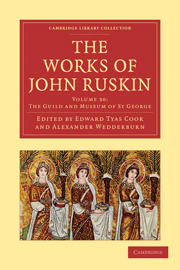Book contents
- Frontmatter
- Contents
- LIST OF ILLUSTRATIONS
- INTRODUCTION TO THIS VOLUME
- PART I THE GUILD OF ST. GEORGE
- I ABSTRACT OF THE OBJECTS AND CONSTITUTION OF ST. GEORGE'S GUILD (1877), WITH THE MEMORANDUM OF ASSOCIATION (1878)
- II THE MASTER'S REPORT (1879)
- III THE MASTER'S REPORT (1881)
- IV GENERAL STATEMENT EXPLAINING THE NATURE AND PURPOSES OF ST. GEORGE'S GUILD (1882)
- V THE MASTER'S REPORT (1884)
- VI THE MASTER'S REPORT (1885)
- VII ACCOUNTS OF THE ST. GEORGE'S GUILD, 1871–1882 (1884)
- VIII ACCOUNTS OF ST. GEORGE'S GUILD, 1881–1883 (1884)
- IX ACCOUNTS OF ST. GEORGE'S GUILD, 1884 (1885)
- X ADDITIONAL PASSAGES RELATING TO ST. GEORGE'S GUILD
- PART II THE ST. GEORGE'S MUSEUM
- APPENDIX
- Plate section
I - ABSTRACT OF THE OBJECTS AND CONSTITUTION OF ST. GEORGE'S GUILD (1877), WITH THE MEMORANDUM OF ASSOCIATION (1878)
Published online by Cambridge University Press: 07 September 2011
- Frontmatter
- Contents
- LIST OF ILLUSTRATIONS
- INTRODUCTION TO THIS VOLUME
- PART I THE GUILD OF ST. GEORGE
- I ABSTRACT OF THE OBJECTS AND CONSTITUTION OF ST. GEORGE'S GUILD (1877), WITH THE MEMORANDUM OF ASSOCIATION (1878)
- II THE MASTER'S REPORT (1879)
- III THE MASTER'S REPORT (1881)
- IV GENERAL STATEMENT EXPLAINING THE NATURE AND PURPOSES OF ST. GEORGE'S GUILD (1882)
- V THE MASTER'S REPORT (1884)
- VI THE MASTER'S REPORT (1885)
- VII ACCOUNTS OF THE ST. GEORGE'S GUILD, 1871–1882 (1884)
- VIII ACCOUNTS OF ST. GEORGE'S GUILD, 1881–1883 (1884)
- IX ACCOUNTS OF ST. GEORGE'S GUILD, 1884 (1885)
- X ADDITIONAL PASSAGES RELATING TO ST. GEORGE'S GUILD
- PART II THE ST. GEORGE'S MUSEUM
- APPENDIX
- Plate section
Summary
1. The St. George's Guild consists of a body of persons who think, primarily, that it is time for honest persons to separate themselves intelligibly from knaves, announcing their purpose, if God help them, to live in godliness and honour, not in atheism and rascality; and who think, secondarily, that the sum which well-disposed persons usually set aside for charitable purposes (namely, the tenth part of their income), may be most usefully applied in buying land for the nation, and entrusting the cultivation of it to a body of well-taught and well-cared-for peasantry.
2. For the teaching of these labourers, schools are to be erected, with museums and libraries in fitting places. The founders’ views of what the education of a peasant should be are explained, passim, in Fors Clavigera.
3. Persons entering the Guild promise, therefore, to give, if so much can be spared, a tenth of their income, or, at all events, whatever they can afford for general charity, to this special object. They undertake, further, to behave honestly and justly to all men, and to obey the Master of the Guild in all matters relating to the management of the affairs of the Guild.
4. The Master is elected by majority of the Guildsmen, and is at any time subject to deposition by majority of votes; but is absolutely uncontrolled in authority, while in office, over all the proceedings of the Guild.
- Type
- Chapter
- Information
- The Works of John Ruskin , pp. 1 - 12Publisher: Cambridge University PressPrint publication year: 2010First published in: 1907



